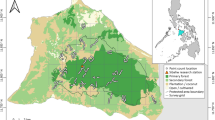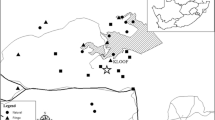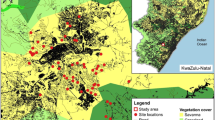Abstract
Understanding the factors determining the occupancy and detection probability of birds in human dominated environments is important for their conservation. In this study we investigated various environmental variables believed to influence the site occupancy and detection probability of Trumpeter Hornbill (Bycanistes bucinator) in urban-forest mosaics of KwaZulu-Natal, South Africa. Presence/absence data were collected from a total of 50 point count stations established between September 2014 and March 2015 in urban-forest mosaics of Durban, Eshowe and Mtunzini. Mean occupancy rate of Trumpeter Hornbill was 0.40 ± 0.09 with a low detection probability of 0.28 ± 0.04. For Trumpeter Hornbills, large trees influenced their occupancy positively (sum AIC weight (ω i ) = 79%) while relative human abundance negatively influenced their occupancy (ω i = 91%). Model selection suggested that housing density had a strong negative influence on detection probability of Trumpeter Hornbills (ω i = 82 % ) and availability of fruiting trees influenced their detection positively (ω i = 29%). With continued changing land use in KwaZulu-Natal, these finding are important for conservation of Trumpeter Hornbills as we provide insight into landscape variables or features that influence Trumpeter Hornbill’s occupancy and detection in areas of urban-forest mosaics.



Similar content being viewed by others
References
Anggraini K, Kinnaird M, O'Brien T (2000) The effects of fruit availability and habitat disturbance on an assemblage of Sumatran hornbills. Bird Conserv Int 10:189–202
Bleher B, Potgieter CJ, Johnson DN, Böhning-Gaese K (2003) The importance of figs for frugivores in a South African coastal forest. J Trop Ecol 19:375–386
Bonier F, Martin PR, Wingfield JC (2007) Urban birds have broader environmental tolerance. Biol Lett 3:670–673
Burnham KP, Anderson DR (2002) Model selection and multimodel inference: a practical information-theoretic approach. Springer, New York
Chace JF, Walsh JJ (2006) Urban effects on native avifauna: a review. Landsc Urban Plan 74:46–69
Chibesa M, Taylor B, Tharmalingam R, Downs CT (2017) Home range and habitat use of trumpeter hornbill in an urban-forest mosaic, Eshowe. South Africa, Ostrich In press
Cilliers SS, Siebert SJ (2012) Urban ecology in Cape Town: South African comparisons and reflections. Ecol Soc 17:33
Cooch E, White G (2005) Program mark: a gentle introduction. Available at: http://www.phidot.org/software/mark/docs/book. downloaded November, 2016
Diefenbach DR, Brauning DW, Mattice JA (2003) Variability in grassland bird counts related to observer differences and species detection rates. Auk 120:1168–1179
Eeley HAC, Lawes MJ, Piper SE (1999) The influence of climate change on the distribution of indigenous forest in KwaZulu-Natal, South Africa. J Biogeogr 26:595–617
Field SA, Tyre AJ, Possingham HP, Lubow BC (2005) Optimizing allocation of monitoring effort under economic and observational constraints. J Wildl Manag 69:473–482
Foley JA, DeFries R, Asner GP, Barford C, Bonan G, Carpenter SR, Chapin FS, Coe MT, Daily GC, Gibbs HK, Helkowski JH, Holloway T, Howard EA, Kucharik CJ, Monfreda C, Patz JA, Prentice IC, Ramankutty N, Snyder PK (2005) Global consequences of land use. Science 309:570
GeoterraImage (2010) 2005/6 ESKOM Dwelling mapping layer. (from SPOT2.5m resolution natural colour satellite imagery) Prepared for ESKOM, South Africa
Gonzalez JCT, Sheldon BC, Collar NJ, Tobias JA (2013) A comprehensive molecular phylogeny for the hornbills (Aves: Bucerotidae). Mol Phylogenet Evol 67:468–483
Grant TA, Madden E, Berkey GB (2004) Tree and shrub invasion in northern mixed-grass prairie: implications for breeding grassland birds. Wildl Soc Bull 32:807–818
Hines JE (2006) PRESENCE-Software to estimate patch occupancy and related parameters.USGS-PWRC. http://www.mbr-pwrc.usgs.gov/software/presence.html
Hockey PAR, Sirami C, Ridley AR, Midgley GF, Babiker HA (2011) Interrogating recent range changes in South African birds: confounding signals from land use and climate change present a challenge for attribution. Divers and Distrib 17:254–261
IUCN (2012) IUCN Red List of Threatened Species (ver. 2012.1). Available at: http://www.iucnredlist.org. downloaded June 2012
Kemp AC, Woodcock M (1995) The hornbills: Bucerotiformes. Oxford University Press, UK
Kinnaird MF, O'Brien TG (2007) The ecology and conservation of Asian hornbills: farmers of the forest. The University of Chicago Press, Chicago
Kitamura S (2011) Frugivory and seed dispersal by hornbills (Bucerotidae) in tropical forests. Acta Oecol 37:531–541
Koper N, Walker DJ, Champagne J (2009) Nonlinear effects of distance to habitat edge on Sprague’s pipits in southern Alberta, Canada. Landsc Ecol 24:1287–1297
Lambert FR, Marshall AG (1991) Keystone characteristics of bird-dispersed ficus in a Malaysian lowland rain forest. J Ecol 79:793–809
Lenz J, Fiedler W, Caprano T, Friedrichs W, Gaese BH, Wikelski M, Böhning-Gaese K (2011) Seed-dispersal distributions by trumpeter hornbills in fragmented landscapes. P Roy Soc B-Biol Sci 278:2257–2264
Lenz J, Böhning-Gaese K, Fiedler W, Mueller T (2015) Nomadism and seasonal range expansion in a large frugivorous bird. Ecography 38:54–62
MacKenzie DI, Royle JA (2005) Designing occupancy studies: general advice and allocating survey effort. J Appl Ecol 42:1105–1114
MacKenzie DI, Nichols JD, Gideon BL, Droege S, Royle JA, Langtimm CA (2002) Estimating site occupancy rates when detection probabilities are less than one. Ecology 83:2248–2255
MacKenzie DI, Nichols JD, Royle JA, Pollock KH, Bailey LL, Hines JE (2006) Occupancy estimation and modeling: inferring patterns and dynamics of species occurrence. Elsevier, Burlington
Marsden SJ (1999) Estimation of parrot and hornbill densities using a point count distance sampling method. Ibis 141:327–390
Marsden SJ, Pilgrim JD (2003) Factors influencing the abundance of parrots and hornbills in pristine and disturbed forests on New Britain, PNG. Ibis 145:45–53
Marzluff J, Bowman R, Donnelly R (2001) A historical perspective on urban bird research: trends, terms, and approaches. In: Marzluff J, Bowman R, Donnelly RD (eds) Avian ecology and conservation in an urbanizing world. Springer, US, pp 1–17
Maseko MST, Ramesh T, Kalle R, Downs CT (2016) Response of crested Guinea-fowl (Guttera edouardi), a forest specialist, to spatial variation in land use in iSimangaliso Wetland Park. South Africa J Ornithol. doi:10.1007/s10336-016-1406-7
McKinney ML (2002) Urbanization, biodiversity, and conservation. Bioscience 52:883–890
McKinney M (2008) Effects of urbanization on species richness: a review of plants and animals. Urban Ecosyst 11:161–176
McPhearson T, Pickett STA, Grimm NB, Niemelä J, Alberti M, Elmqvist T, Weber C, Haase D, Breuste J, Qureshi S (2016) Advancing urban ecology toward a science of cities. BioScience. doi:10.10993/biosci/biw002
Mucina L, Rutherford MC (2006) The vegetation of South Africa, Lesotho and Swaziland, Strelitzia 19. South African National Biodiversity Institute, Pretoria
Mueller T, Lenz J, Caprano T, Fiedler W, Böhning-Gaese K (2014) Large frugivorous birds facilitate functional connectivity of fragmented landscapes. J Appl Ecol 51:684–692
Otis DL, Burnham KP, White GC, Anderson DR (1978) Statistical inference from capture data on closed animal populations. Wildl Monogr 3:135
Péron G, Altwegg R (2015) Twenty-five years of change in southern African passerine diversity: nonclimatic factors of change. Glob Chang Biol 21:3347–3355
Poonswad P, Sukkasem C, Phataramata S, Hayeemuida S, Plongmai K, Chuailua P, Thiensongrusame P, Jirawatkavi N (2005) Comparison of cavity modification and community involvement as strategies for hornbill conservation in Thailand. Biol Conserv 122:385–393
Poonswad P, Kemp A, Strange M, Laman T (2013) Hornbills of the world: a photographic guide. Draco Publishing and Distribution, Singapore
Purcell KL, Mori SR, Chase MK (2005) Design considerations for examining trends in avian abundance using point counts: examples from oak woodlands. Condor 107:305–320
Ralph CJ, Droege S, Sauer JR (1995) Managing and monitoring birds using point counts: Standards and applications. USDA Forest Service. Technical Report. PSW-GTR-149
Ramesh T, Downs CT (2014) Land use factors determining occurrence of red-necked Spurfowl (Pternistis afer) in the Drakensberg midlands, South Africa. J Ornithol 155:471–480
Royle JA, Nichols JD (2003) Estimating abundance from repeated presence-absence data or point counts. Ecology 84:777–790
Sliwinski M, Powell L, Koper N, Giovanni M, Schacht W (2015) Research design considerations to ensure detection of all species in an avian community. Methods Ecol Evol 7:456–462
Trail PW (2007) African hornbills: keystone species threatened by habitat loss, hunting and international trade. Ostrich 78:609–613
UN (2014) World urbanisation prospects: working paper no. ST/ESA/SER.A/352. United Nation Department of Economic and Social Affairs, Population Division, New York
UN (2015) World population prospects: working paper no. ESA/P/WP. 241. United Nation Department of Economic and Social Affairs, Population Division, New York
Vačkář D, Brink ten B, Loh J, Baillie JEM, Reyers B (2012) Review of multispecies indices for monitoring human impacts on biodiversity. Ecol Indic 17:58–67
Viseshakul N, Charoennitikul W, Kitamura S, Kemp A, Thong-Aree S, Surapunpitak Y, Poonswad P, Ponglikitmongkol M (2011) A phylogeny of frugivorous hornbills linked to the evolution of Indian plants within Asian rainforests. J Evol Biol 24:1533–1545
White GC, Burnham KP (1999) Program MARK: survival estimation from populations of marked animals. Bird Study 46:S120–S139
Winarni NL, Jones M (2012) Effect of anthropogenic disturbance on the abundance and habitat occupancy of two endemic hornbill species in Buton island, Sulawesi. Bird Conserv Int 22:222–233
WWF (2016) Living Planet Report (2014). Risk and resilience in a new era. WWF International, Switzerland
Acknowledgements
We thank the National Research Foundation (ZA), University of KwaZulu-Natal (South Africa) and the Copperbelt University (Zambia) for the financial assistance provided to the first author. We thank EKZN Wildlife for granting us permission to conduct research in their nature reserves. We thank all nature conservancies in KZN for assisting with information on Trumpeter Hornbill sightings. Last but not the least, thanks to all graduate and post-graduate students that assisted with data collection with regards to point count station establishment and recording data on large trees, fruiting trees and relative human abundance.
Author information
Authors and Affiliations
Corresponding author
Rights and permissions
About this article
Cite this article
Chibesa, M., Downs, C.T. Factors determining the occupancy of Trumpeter Hornbills in urban-forest mosaics of KwaZulu-Natal, South Africa. Urban Ecosyst 20, 1027–1034 (2017). https://doi.org/10.1007/s11252-017-0656-3
Published:
Issue Date:
DOI: https://doi.org/10.1007/s11252-017-0656-3




